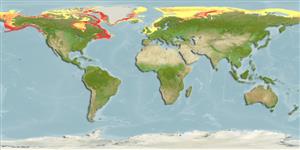Environment: milieu / climate zone / depth range / distribution range
Ecologia
marinhas demersal; intervalo de profundidade 0 - 647 m (Ref. 50610), usually 100 - 200 m (Ref. 5951). Polar; 84°N - 43°N, 180°W - 180°E (Ref. 117245)
Arctic, Northwest to Northeast Atlantic, Northeast Pacific: Greenland, Canada, and southeastern Alaska (Ref. 2850).
Tamanho / Peso / Idade
Maturity: Lm ? range ? - ? cm
Max length : 52.0 cm TL macho/indeterminado; (Ref. 2850)
Occurs among seaweeds or rocks (Ref. 7251). Often found in empty scallop shells (Ref. 7251). Benthic species. Feeds on crustaceans (Ref. 58426), such as amphipods and crabs (Ref. 5951).
Ciclo de vida ou comportamento de acasalamento
Maturities | Reprodução | Spawnings | Egg(s) | Fecundities | Larvas
Robins, C.R., R.M. Bailey, C.E. Bond, J.R. Brooker, E.A. Lachner, R.N. Lea and W.B. Scott, 1991. Common and scientific names of fishes from the United States and Canada. Am. Fish. Soc. Spec. Publ. (20):183 p. (Ref. 3814)
Status na Lista Vermelha da UICN (Ref. 130435)
Ameaça para os humanos
Harmless
Uso pelos humanos
Ferramentas
Relatórios especiais
Baixar XML
Fontes da internet
Estimates based on models
Preferred temperature (Ref.
123201): -1.4 - 5.9, mean -0.3 °C (based on 868 cells).
Índice de diversidade filogenética (Ref.
82804): PD
50 = 0.5000 [Uniqueness, from 0.5 = low to 2.0 = high].
Bayesian length-weight: a=0.01148 (0.00483 - 0.02731), b=3.05 (2.84 - 3.26), in cm total length, based on LWR estimates for this (Sub)family-body shape (Ref.
93245).
Nível Trófico (Ref.
69278): 3.7 ±0.3 se; based on diet studies.
Resiliência (Ref.
120179): médio(a), tempo mínimo de duplicação da população 1,4 - 4,4 anos (Fec=4,000-12,000).
Fishing Vulnerability (Ref.
59153): Moderate vulnerability (41 of 100).
